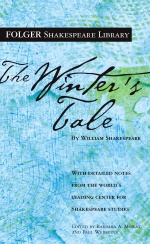The Winter's Tale
The Winter's Tale, a very late one of William Shakespeare's plays, is filled with improbabilities. Before the conclusion, one character comments that what we are about to see, "Were it but told you, should be hooted at / Like an old tale."
It includes murderous passions, man-eating bears, princes and princesses in disguise, death by drowning and by grief, oracles, betrayal, and unexpected joy. Yet the play, which draws much of its power from Greek myth, is grounded in the everyday.
A "winter's tale" is one told or read on a long winter's night. Paradoxically, this winter's tale is ideally seen rather than read—though the imagination can transform words into vivid action. Its shift from tragedy to comedy, disguises, and startling exits and transformations seem addressed to theater audiences.
Shakespeare is thought to have written The Winter’s Tale in 1609–11; it was performed at the Globe in May 1611 and at court that November. It was published in the 1623 First Folio. The chief source is Robert Greene’s Pandosto, or the Triumph of Time.[1]
Productions at the Folger
- Helen Hayes Awards
- Nominations: "Outstanding Supporting Actress, Resident Play" for Naomi Jacobson
Early editions
First Folio
- LUNA: First Folio: 2a1r - 2c2r
- Hamnet: STC 22273 Fo. 1 no. 68
Second Folio
- LUNA: Second Folio: 2a1r - 2c2v
- Hamnet: STC 22274 Fo. 2 no. 07
Modern editions
The Winter's Tale can be read online with Folger Digital Texts and purchased from Simon and Schuster.
- Hamnet link to Folger Edition: PR2753 .M6 2003 copy 2 v.37
In popular culture
Translations
Performance materials
Other media
Notes
<references>
- ↑ Adapted from the Folger Library Shakespeare edition, edited by Barbara A. Mowat and Paul Werstine. © 1998 Folger Shakespeare Library.
